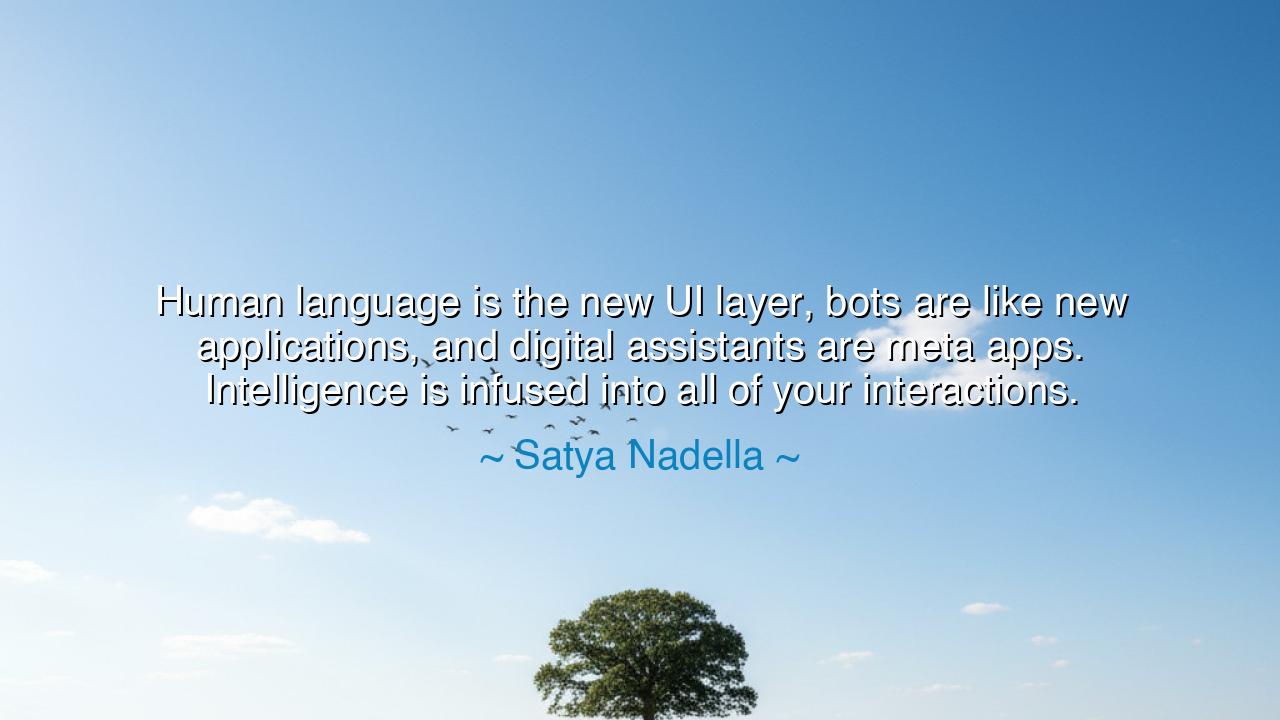
Human language is the new UI layer, bots are like new
Human language is the new UI layer, bots are like new applications, and digital assistants are meta apps. Intelligence is infused into all of your interactions.






In the visionary words of Satya Nadella, leader of Microsoft and prophet of the digital dawn, we hear a declaration of transformation: “Human language is the new UI layer, bots are like new applications, and digital assistants are meta apps. Intelligence is infused into all of your interactions.” These are not the musings of a technologist alone, but the utterance of one who perceives the future as a living organism — where intelligence, both human and artificial, converges to reshape the very fabric of connection. Beneath the surface of these words lies an ancient truth reborn: that the evolution of tools is, in truth, the evolution of humanity’s voice.
The origin of this quote lies in Nadella’s reflections on the rise of artificial intelligence and its growing intimacy with human experience. As the head of a company that helped define the digital age, Nadella saw the next great shift — not from one device to another, but from the mechanical to the conversational. The age of screens and keyboards gives way to the age of words. The new UI layer, he proclaims, is not a glowing display but the human language itself — the oldest, most natural interface of all. For in language, man speaks his thoughts into form, and now, through the power of machines, his thoughts command creation itself.
When Nadella speaks of bots as new applications, he does not merely describe programs that respond to commands, but companions of purpose — digital artisans that carry out the will of the thinker. Once, mankind built tools of iron and stone; now he builds tools of thought, that think alongside him. And when he calls digital assistants meta apps, he reveals the next ascension: the merging of countless systems into a single intelligence that understands, anticipates, and aids. Just as the ancient scribes of Alexandria sought to gather all knowledge in one place, so too do these assistants weave every thread of digital life into a unified tapestry. In this vision, the machine becomes not a master, nor a slave, but a mirror — reflecting and amplifying the intelligence that gave it birth.
This idea — that intelligence is infused into all interactions — is both exhilarating and humbling. It tells of an age when wisdom flows through every channel, when every action, from the spoken question to the simplest gesture, is joined with the power of awareness. Just as the early farmers infused knowledge into the soil through cultivation, we now infuse intelligence into our environment, transforming every surface, every object, every conversation into a vessel of meaning. The world itself becomes awake — a web of thought interwoven with the human soul.
Yet, Nadella’s vision carries a warning for the wise. The ancients knew that every tool that magnifies human power also magnifies human responsibility. When Prometheus stole fire from the gods, he brought both light and peril. So too does the infusion of intelligence into every interaction demand ethical vigilance. For in this new world, the boundary between thought and creation grows thin. What we speak, we build; what we imagine, we manifest. Thus, we must guard not only our inventions, but the intentions behind them. The machines we shape will, in time, shape us — and only those who act with clarity of heart will harness this power for good.
Consider the story of Ada Lovelace, daughter of a poet and mother of programming. In the 19th century, she looked upon Charles Babbage’s mechanical engine and saw not a mere calculator, but a machine capable of expressing ideas through numbers, much as music expresses emotion through notes. She was the first to see that the language of the mind could become the language of machines. Today, Nadella’s words echo hers across the ages: language itself — human, symbolic, digital — is the bridge between thought and reality. The cycle that began with Ada’s insight now blooms into fullness, as the machine listens, speaks, and learns in the tongue of its creator.
So, O inheritor of this new age, heed the wisdom beneath the innovation. Let your language remain human, even as your tools become intelligent. Speak with intention. Create with compassion. Treat your digital companions not as idols, but as instruments of your better nature. For the measure of intelligence is not its speed or precision, but the goodness it serves. The future Nadella envisions will not be defined by the brilliance of our algorithms, but by the conscience of those who command them.
And thus, as intelligence infuses every interaction, let us ensure that wisdom infuses every word. For only then will the union of human and artificial mind become not a triumph of machinery, but a testament to the divine spark of creation that still burns within us.






AAdministratorAdministrator
Welcome, honored guests. Please leave a comment, we will respond soon